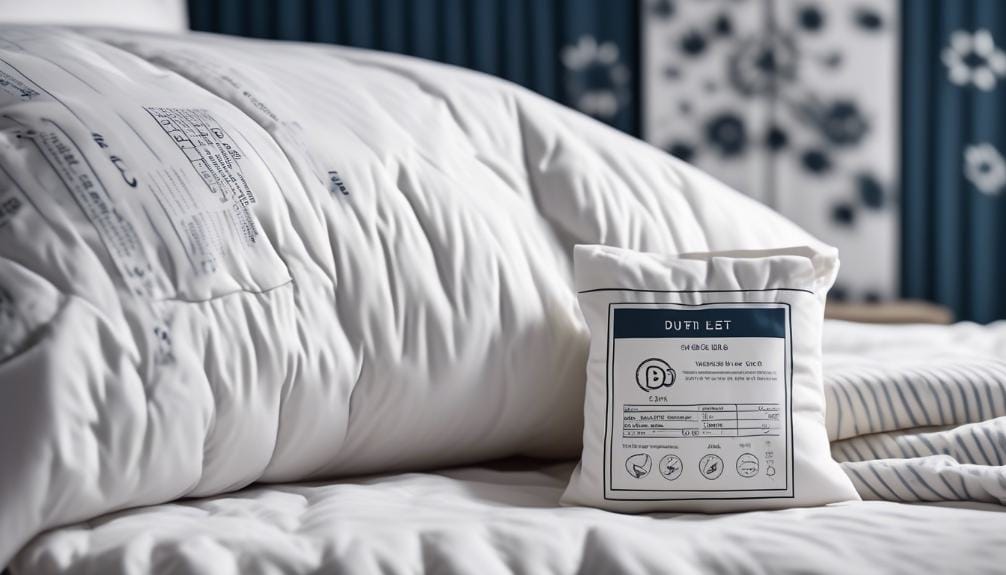How to Clean a Duvet Cover for a Refreshed Space
Did you know that the average person spends about one-third of their life in bed? With that much time spent in one place, it’s crucial to keep your bedding fresh and clean.
When it comes to creating a refreshed and inviting space, cleaning your duvet cover is key. Whether you’re dealing with everyday wear and tear or just want to give your bedroom a quick pick-me-up, knowing how to properly clean your duvet cover is essential.
From understanding care labels to choosing the right washing method, there are several steps to consider. So, let’s dive into the details of how to clean a duvet cover for a space that feels brand new.
Key Takeaways
- Carefully read and understand the care labels for proper maintenance of duvet covers
- Different duvet covers have varying care requirements, so check the label to determine if it is machine washable or requires dry cleaning
- Pre-treat and repair stains on the duvet cover before washing to prevent further damage
- Use appropriate drying techniques, such as low heat settings or air drying, to preserve the fabric’s integrity and maintain the quality of feather or down duvet covers.
Understanding Duvet Cover Care Labels

When caring for your duvet cover, it’s crucial to carefully read and understand the care labels to ensure proper maintenance. Different duvet covers have varying care requirements, so it’s essential to pay attention to the care label instructions.
Check the label to determine if your duvet cover is machine washable or if it requires dry cleaning. If your duvet cover contains natural oils or filling, it’s important to use a gentle washing cycle to prevent damage. Feather and down duvet covers should be washed at a delicate setting with a low temperature and no spin cycle to maintain their quality.
On the other hand, most synthetic duvet covers can withstand a warm gentle cycle at a maximum of 30 degrees. Additionally, washing at 60°C effectively eliminates dust mites, ensuring a clean and hygienic duvet cover.
Understanding the care labels ensures that your duvet cover remains clean and well-maintained, allowing you to enjoy a refreshed and comfortable sleeping space.
Pre-Treating and Repairing Stains

To effectively pre-treat and repair stains on your duvet cover, begin by identifying any teared seams and promptly sewing them to prevent further damage during the washing process.
It’s essential to isolate any stains on the duvet cover before proceeding with the washing process. Shake loose feathers away from the duvet cover to prevent them from spreading and sticking to the fabric during the pre-treating process. Use a good stain remover or baking soda to treat stains, ensuring to follow the product’s instructions for best results.
Before washing your duvet cover, it’s crucial to repair any weak spots to prevent them from worsening during the cleaning process. Use a gentle laundry detergent that’s suitable for natural oils and fibers, as this will help preserve the quality of the duvet cover. Additionally, consider using a duvet insert to protect the cover from direct contact with any stains.
After pre-treating and repairing stains, wash the duvet cover according to the care label instructions and dry it thoroughly, ensuring it’s completely dry before putting it back on your duvet.
Choosing the Right Washing Method

Consider checking the care label for specific washing instructions to ensure you’re using the appropriate method for cleaning your duvet cover. It’s crucial to follow the manufacturer’s recommendations to prevent any damage to the duvet cover.
When choosing the right washing method, make sure to use a washing machine that can accommodate the size of the duvet. If the cover is very dirty, consider pre-soaking it before washing. Additionally, using a mild detergent suitable for sensitive skin will help keep your duvet cover clean and fresh without causing any irritation.
It’s important to select the right method to ensure that your duvet cover is thoroughly cleaned and maintains its quality. By following these guidelines, you can effectively clean your duvet cover and create a refreshed space in your bedroom.
Choosing the appropriate washing method is essential to preserve the integrity of the fabric and to ensure that your duvet cover continues to enhance the overall look of your space.
Drying Techniques for a Fresh Duvet Cover

After choosing the right washing method to clean your duvet cover, it’s essential to employ proper drying techniques to ensure the fabric remains undamaged and fresh. To achieve the best results, follow these drying techniques for a fresh duvet cover:
- Use a low heat setting in the dryer: When using a dryer, set it to a low heat setting to prevent any potential damage to the fabric of the duvet cover. This gentle drying approach will help maintain the quality of the material.
- Consider using dryer balls: Place wool dryer balls in the dryer along with the duvet cover to prevent clumps from forming. The balls will help to fluff up the duvet cover and promote even drying without the use of harsh chemicals.
- Air dry delicate materials: If you have a feather or down duvet cover, avoid tumble drying. Instead, air-dry these delicate materials to maintain their quality. Ensure the duvet cover is completely dry before reassembling it on your duvet for a refreshed space.
Maintenance Tips for a Clean Duvet Cover

For proper maintenance of a clean duvet cover, it is important to follow specific guidelines to ensure its longevity and cleanliness. Here are some essential maintenance tips to keep your duvet cover in top condition:
| Maintenance Tips | Description |
|---|---|
| Wash Frequency | Clean your duvet cover every six months or once a year, especially if you suffer from allergies. |
| Remove Cover Before Washing | Ensure a more effective clean and proper cleaning of the duvet itself by removing the cover. |
| Repair Before Washing | Sew any torn seams and treat stains before washing to prevent further damage and ensure a thorough clean. |
| Check Care Label | Carefully follow the washing requirements indicated on the label for effective cleaning. |
| Proper Drying | Thoroughly dry the duvet before use, using a low heat tumble-dryer or air-drying for feather and down duvets. |
Following these maintenance tips will help keep your duvet cover clean and fresh, ensuring a comfortable and rejuvenating space. Remember to always check the care label and follow these maintenance tips to prolong the life of your duvet cover.
Frequently Asked Questions
How Do You Refresh a Duvet Cover?
To refresh a duvet cover, start by shaking it out to remove any dust or debris. Then, wash it in cold water with mild detergent and tumble dry on low heat. Lastly, give it a quick iron to smooth out any wrinkles for a fresh look.
How Do You Freshen a Duvet Without Washing It?
To freshen a duvet without washing it, simply shake it out and hang it in the sun for a few hours. You can also use a fabric refresher spray or toss it in the dryer with a scented sheet for a quick refresh.
Can I Wash My Duvet Cover in the Washing Machine?
Yes, you can wash your duvet cover in the washing machine. Be sure to check the label for any specific instructions. Use a gentle cycle with mild detergent, and avoid using bleach or fabric softener. Tumble dry on low heat.
How Do You Wash a Rest Duvet Cover?
To wash a rest duvet cover, turn it inside out and close the zipper. Wash it in cold water with a gentle detergent, then tumble dry on low heat or air dry. Iron on low if needed.
Conclusion
Now that you’ve learned how to clean your duvet cover, you can keep it looking fresh and feeling comfortable for a long time.
Remember to always check the care labels, pre-treat stains, choose the right washing method, and use proper drying techniques.
With the right maintenance, your duvet cover will continue to provide a clean and cozy space for you to enjoy.
